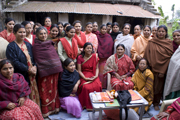New Zealand
May 5, 2008
 Staff
working within Crop & Food
Research’s forage breeding programmes are spearheading a new
and exciting project to alleviate poverty within farming
communities in Nepal, and improving household incomes from milk
sales. Staff
working within Crop & Food
Research’s forage breeding programmes are spearheading a new
and exciting project to alleviate poverty within farming
communities in Nepal, and improving household incomes from milk
sales.
NZAID, the New Zealand Government’s international aid and
development agency, will contribute funding to the project,
which is aimed at reducing the significant labour time that some
Nepalese women spend in gathering and transporting fodder for
livestock.
The goal is for farmers to produce their own higher quality
fodder to improve milk yields, and free up significant time for
farming families, which can then be re-directed into other
income-generating activities.
 Project leader in New Zealand, Keith Armstrong
(photo), says woman dairy
farmers in Nepal have to go out and cut forage for the livestock
from common lands, often at great distance, and often spending
all day at the task. The inadequate levels of fodder that are
able to be collected in winter and spring, lead to poor animal
nutrition, and consequently poor milk productivity. Project leader in New Zealand, Keith Armstrong
(photo), says woman dairy
farmers in Nepal have to go out and cut forage for the livestock
from common lands, often at great distance, and often spending
all day at the task. The inadequate levels of fodder that are
able to be collected in winter and spring, lead to poor animal
nutrition, and consequently poor milk productivity.
“At Crop & Food Research we have developed excellent oat
varieties that can be grown in the Himalayan regions during
winter when the need for fodder is greatest. An earlier project
that we were involved with was able to test the ability of these
crops to be grown, along with legumes, so we are confident that
this new fodder programme can be rolled-out on a wider and more
sustainable scale.”
Mr Armstrong says the Nepal Agricultural Research Council and
Department of Livestock Services will oversee in-country
implementation and will also provide financial and in-kind
support. Importantly, the farmers are enormously supportive and
will be strongly involved in this participatory project.
“We are delighted that NZAID has seen the worth of this project
to poor farming communities within Nepal. Livestock contribute
significantly to incomes through milk production, provision of
food and as draught power for land cultivation. If we can ensure
that the animals are fitter through provision of high-quality
fodder, as well as reducing the need for women to go out and
gather the fodder, often over large distances, then we can
expect to see significant improvements in the overall well-being
of these rural communities.” |
|